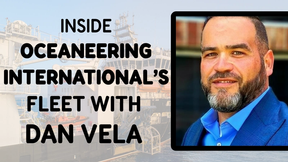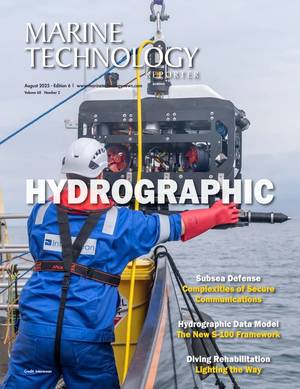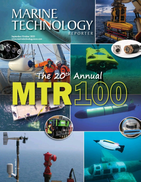Marine Technology Reporter Blogs - electricity
Subsea Instrumentation: CTD Devices

CTD stands for conductivity, temperature, and depth, and refers to a package of electronic instruments that measure these properties. A device called CTD Rosette is lowered into the water and down to the seafloor to measure the salinity, temperature, depth and concentration of particles in the water column. A CTD device’s primary function is to detect how the conductivity and temperature of the water column changes relative to depth. Conductivity is a measure of how well a solution conducts electricity. Conductivity is directly related to salinity, which is the concentration of salt and other inorganic compounds in seawater. Salinity is one of the most basic measurements used by ocean scientists.
Subsea Instrumentation: CTD Devices
CTD stands for conductivity, temperature, and depth, and refers to a package of electronic instruments that measure these properties. A device called CTD Rosette is lowered into the water and down to the seafloor to measure the salinity, temperature, depth and concentration of particles in the water column. A CTD device’s primary function is to detect how the conductivity and temperature of the water column changes relative to depth. Conductivity is a measure of how well a solution conducts electricity. Conductivity is directly related to salinity, which is the concentration of salt and other inorganic compounds in seawater. Salinity is one of the most basic measurements used by ocean scientists.
Subsea Instrumentation: CTD Devices
CTD stands for conductivity, temperature, and depth, and refers to a package of electronic instruments that measure these properties. A device called CTD Rosette is lowered into the water and down to the seafloor to measure the salinity, temperature, depth and concentration of particles in the water column. A CTD device’s primary function is to detect how the conductivity and temperature of the water column changes relative to depth. Conductivity is a measure of how well a solution conducts electricity. Conductivity is directly related to salinity, which is the concentration of salt and other inorganic compounds in seawater. Salinity is one of the most basic measurements used by ocean scientists.
Subsea Instrumentation: CTD Devices
CTD stands for conductivity, temperature, and depth, and refers to a package of electronic instruments that measure these properties. A device called CTD Rosette is lowered into the water and down to the seafloor to measure the salinity, temperature, depth and concentration of particles in the water column. A CTD device’s primary function is to detect how the conductivity and temperature of the water column changes relative to depth. Conductivity is a measure of how well a solution conducts electricity. Conductivity is directly related to salinity, which is the concentration of salt and other inorganic compounds in seawater. Salinity is one of the most basic measurements used by ocean scientists.
Subsea Instrumentation: CTD Devices
CTD stands for conductivity, temperature, and depth, and refers to a package of electronic instruments that measure these properties. A device called CTD Rosette is lowered into the water and down to the seafloor to measure the salinity, temperature, depth and concentration of particles in the water column. A CTD device’s primary function is to detect how the conductivity and temperature of the water column changes relative to depth. Conductivity is a measure of how well a solution conducts electricity. Conductivity is directly related to salinity, which is the concentration of salt and other inorganic compounds in seawater. Salinity is one of the most basic measurements used by ocean scientists.
Albatern WaveNET - Wave Energy System

Albatern is a company specialized in designing and assembling wave energy generators to produce electricity from the energy industry.WaveNET is AlbaTERN’s wave energy array system. Constructed from multiple SQUID modules, the array can be readily adapted to suit the specifications of the site and the customer’s power requirements. A prototype array comprising 6 modules with a rated capacity of 45kW has been built. Larger arrays (250kW +) can be assembled at the current scale. The unique WaveNET wave energy conversion system is based around a series of smaller interconnected units called Squids. This approach reduces the operational challenges of handling and deploying very large structures while allowing the device to be tailored to the requirements of a particular site.
Pelamis P2 – How the Wave Energy Converter Operates

The Pelamis P2 is the second-generation Pelamis Wave Energy machine and includes a number of significant design improvements. The P2 design has been sold to utility customers E.ON and ScottishPower Renewables and are currently being tested for a number of commercial scale projects. At 180m long, 4m diameter and weighing around 1350 tons (mostly sand ballast), the P2 Pelamis is wider, longer and heavier than the P1 design machine. This allows the Pelamis to capture more energy while substantially reducing the cost per MW. Comprised of five tubes with four joints, the P2 has an extra tube section and an extra power module. An improved power take off system for the P2 allows higher efficiencies, enhanced control resolution and increased reliability.


 August 2025
August 2025



